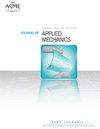复合刚度的平衡破坏
IF 2.8
4区 工程技术
Q2 MECHANICS
引用次数: 0
摘要
来自金属、弹性体和砂土循环试验的证据表明,阻尼力几乎与速率无关,自20世纪40年代以来,结构(滞后或速率无关)阻尼被广泛采用。虽然与速率无关阻尼器并联的线性弹簧没有时域本构方程,但该机械网络的动态刚度(传递函数)可以在频域中构造;自20世纪60年代初以来,人们就知道这种机械网络表现出非因果反应。鉴于其简单性以及对速率无关耗散建模的广泛实际需求,该机械网络也在具有标签复刚度的时域公式中实现,其中力输出P(t)在时域中与位移输入u(t)相关,其中P(t。本文表明,不同学者在时域中表达的复刚度是一个有根本缺陷的结构,因为除了因果关系外,它还违反了平衡。本文章由计算机程序翻译,如有差异,请以英文原文为准。
Equilibrium Violation from the Complex Stiffness
Evidence from cyclic tests on metals, elastomers and sandy soils reveals that damping forces are nearly rate-independent and structural (hysteretic or rate-independent) damping was widely adopted since the 1940s. While there is no time-domain constitutive equation for a linear spring connected in parallel with a rate-independent dashpot, the dynamic stiffness (transfer function) of this mechanical network can be constructed in the frequency-domain; and it was known since the early 1960s that this mechanical network exhibits a non-causal response. In view of its simplicity in association with the wide practical need to model rate-independent dissipation, this mechanical network was also implemented in time-domain formulations with the label complex stiffness where the force output, P(t) is related in the time-domain to the displacement input, u(t), with P(t) = k(1 + i η)u(t). This paper shows that the complex stiffness, as expressed in the time-domain by various scholars, is a fundamentally flawed construct since in addition to causality it violates equilibrium.
求助全文
通过发布文献求助,成功后即可免费获取论文全文。
去求助
来源期刊
CiteScore
4.80
自引率
3.80%
发文量
95
审稿时长
5.8 months
期刊介绍:
All areas of theoretical and applied mechanics including, but not limited to: Aerodynamics; Aeroelasticity; Biomechanics; Boundary layers; Composite materials; Computational mechanics; Constitutive modeling of materials; Dynamics; Elasticity; Experimental mechanics; Flow and fracture; Heat transport in fluid flows; Hydraulics; Impact; Internal flow; Mechanical properties of materials; Mechanics of shocks; Micromechanics; Nanomechanics; Plasticity; Stress analysis; Structures; Thermodynamics of materials and in flowing fluids; Thermo-mechanics; Turbulence; Vibration; Wave propagation

 求助内容:
求助内容: 应助结果提醒方式:
应助结果提醒方式:


